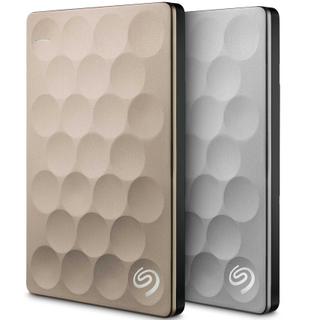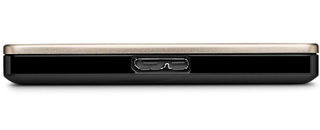Seagate Launches Backup Plus Ultra Slim, SMR Hits The 2.5-Inch Segment
Seagate's new Backup Plus Ultra Slim, which the company unveiled at CES 2016, reduces the thickness (Z-height) of its 1 and 2 TB enclosures to a mere 9.6 mm. Competing mobile HDD enclosures feature a Z-height of 20.9 mm (51 percent thicker), and the previous-generation mobile Seagate 2 TB HDD already provided the thinnest profile at 12.1 mm.
The new Seagate 5,400 RPM mobile 2 TB HDD with a 7 mm Z-height is nestled inside the enclosure, and is the key technological advance that enabled the thinner enclosure. Seagate managed to pack up to two platters into the thin drive and coupled them with its SMR technology, which is a first for the 2.5" HDD segment.

The svelte design allows users to tote around more data in a slimmer package. Seagate included its Dashboard software, which allows users to configure either one-click or customized scheduled backups for their devices. Seagate also provides a few extras for its customers, including 200 GB of OneDrive cloud storage for two years and the Lyve photo and video sharing application, which merges photos and videos into a single automatically managed library that is accessible from any computer or mobile device.

The slim design features either a golden or platinum motif and the USB 3.0 connection, which is the primary speed limitation. Both the 1 and the 2 TB models are expected to provide enough speed to saturate the bus. The drive is compatible with the downloadable Paragon driver, which allows the use of the Backup Plus with both Windows and Apple machines.
The company referenced its "breakthrough ultra-mobile hard drive technology" as the driver behind the increased density, which refers (at least in part) to its SMR technology. SMR (Shingled Magnetic Recording) is a revolutionary new HDD recording technique that overlaps an HDD's tracks to improve storage density (we have a deeper explanation in our SMR 101 article) in comparison to the commonly-used PMR recording (which is found in the vast majority of HDDs).

The only disadvantage to SMR recording is that it suffers slow performance in some workloads due to the nature of the overlapped data tracks, which have to be re-written in large blocks whenever data is changed or moved. The internal functions of an SMR drive borrow heavily from SSD technology, namely the technique of abstracting the sector mapping scheme, to reduce the overall impact of the inevitable data re-write process.
As a result, SMR drives are unsuitable for any type of random write data but perform fine with sequential data. SMR HDDs debuted in the enterprise space with the Seagate Archive 8TB HDD, which brought the cost-per-GB down to a mere 3 cents-per-GB. Unfortunately, the architecture requires customizations to the broader computing environment to mitigate the performance limitations, which has hampered adoption (particularly in the face of very efficient helium HDDs).
Stay On the Cutting Edge: Get the Tom's Hardware Newsletter
Get Tom's Hardware's best news and in-depth reviews, straight to your inbox.
In an effort to increase adoption, Seagate is expanding its SMR scope to the client space for select applications, such as backup, archival tasks, videos and photo storage. Seagate is wise to position the drives for backup, photo and video applications. These types of data almost always consist of large-block sequential data patterns, thus preventing users from experiencing any noticeable performance slowdown.
SMR is geared to provide increased density and reduced cost. The Backup Plus Ultra Slim will retail for $99.99 for the 1 TB model and $129.99 for the 2 TB model. The new Backup Plus Ultra Slim features a two-year warranty, which is the same as the previous-generation PMR-based product.
The Seagate Backup Plus Ultra Slim will be available in the first quarter of 2016 at either Amazon or Seagate.com and features a two-year warranty.

Paul Alcorn is the Managing Editor: News and Emerging Tech for Tom's Hardware US. He also writes news and reviews on CPUs, storage, and enterprise hardware.
-
Chrysocyon Just a minor correction, 51% thicker than of 9.6mm would be 14.5mm; 20.9mm would be 118% thicker, while 9.6mm would be about 53% thinner.Reply


